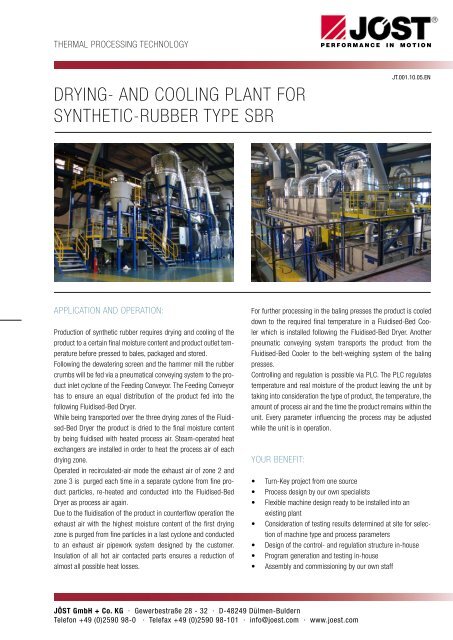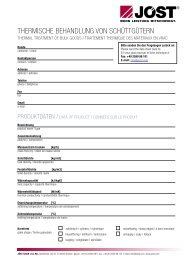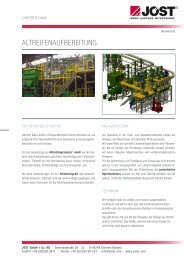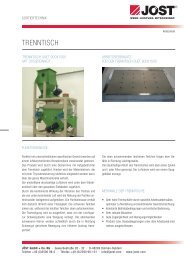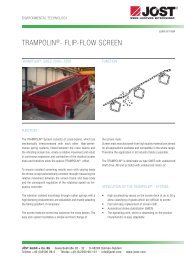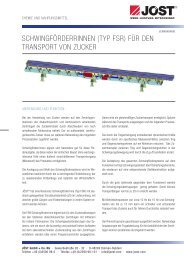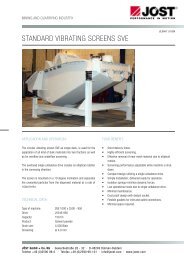and Cooling Plant for Synthetic-Rubber Type - JÖST GmbH + Co.KG
and Cooling Plant for Synthetic-Rubber Type - JÖST GmbH + Co.KG
and Cooling Plant for Synthetic-Rubber Type - JÖST GmbH + Co.KG
You also want an ePaper? Increase the reach of your titles
YUMPU automatically turns print PDFs into web optimized ePapers that Google loves.
thermal ProCeSSing teChnology P E R F O R M A N C E i N M O t i O N<br />
Drying- anD <strong><strong>Co</strong>oling</strong> <strong>Plant</strong> <strong>for</strong><br />
SynthetiC-rubber tyPe Sbr<br />
aPPliCation anD oPeration:<br />
Production of synthetic rubber requires drying <strong>and</strong> cooling of the<br />
product to a certain final moisture content <strong>and</strong> product outlet temperature<br />
be<strong>for</strong>e pressed to bales, packaged <strong>and</strong> stored.<br />
Following the dewatering screen <strong>and</strong> the hammer mill the rubber<br />
crumbs will be fed via a pneumatical conveying system to the product<br />
inlet cyclone of the Feeding <strong>Co</strong>nveyor. The Feeding <strong>Co</strong>nveyor<br />
has to ensure an equal distribution of the product fed into the<br />
following Fluidised-Bed Dryer.<br />
While being transported over the three drying zones of the Fluidised-Bed<br />
Dryer the product is dried to the final moisture content<br />
by being fluidised with heated process air. Steam-operated heat<br />
exchangers are installed in order to heat the process air of each<br />
drying zone.<br />
Operated in recirculated-air mode the exhaust air of zone 2 <strong>and</strong><br />
zone 3 is purged each time in a separate cyclone from fine product<br />
particles, re-heated <strong>and</strong> conducted into the Fluidised-Bed<br />
Dryer as process air again.<br />
Due to the fluidisation of the product in counterflow operation the<br />
exhaust air with the highest moisture content of the first drying<br />
zone is purged from fine particles in a last cyclone <strong>and</strong> conducted<br />
to an exhaust air pipework system designed by the customer.<br />
Insulation of all hot air contacted parts ensures a reduction of<br />
almost all possible heat losses.<br />
your benefit:<br />
<strong>JÖST</strong> <strong>GmbH</strong> + <strong>Co</strong>. <strong>KG</strong> · Gewerbestraße 28 - 32 · D-48249 Dülmen-Buldern<br />
Telefon +49 (0)2590 98-0 · Telefax +49 (0)2590 98-101 · info@joest.com · www.joest.com<br />
•<br />
•<br />
•<br />
•<br />
•<br />
•<br />
•<br />
JT.001.10.05.EN<br />
For further processing in the baling presses the product is cooled<br />
down to the required final temperature in a Fluidised-Bed <strong>Co</strong>oler<br />
which is installed following the Fluidised-Bed Dryer. Another<br />
pneumatic conveying system transports the product from the<br />
Fluidised-Bed <strong>Co</strong>oler to the belt-weighing system of the baling<br />
presses.<br />
<strong>Co</strong>ntrolling <strong>and</strong> regulation is possible via PLC. The PLC regulates<br />
temperature <strong>and</strong> real moisture of the product leaving the unit by<br />
taking into consideration the type of product, the temperature, the<br />
amount of process air <strong>and</strong> the time the product remains within the<br />
unit. Every parameter influencing the process may be adjusted<br />
while the unit is in operation.<br />
Turn-Key project from one source<br />
Process design by our own specialists<br />
Flexible machine design ready to be installed into an<br />
existing plant<br />
<strong>Co</strong>nsideration of testing results determined at site <strong>for</strong> selection<br />
of machine type <strong>and</strong> process parameters<br />
Design of the control- <strong>and</strong> regulation structure in-house<br />
Program generation <strong>and</strong> testing in-house<br />
Assembly <strong>and</strong> commissioning by our own staff
thermal ProCeSSing teChnology P E R F O R M A N C E i N M O t i O N<br />
teChniCal Data:<br />
Feeding <strong>Co</strong>nveyor<br />
<strong>Type</strong> of machine: FUF 1200 x 2500<br />
Width: 1.200 mm<br />
Length: 2.500 mm<br />
Weight: ca. 2,3 t<br />
Drives: 2 x JV 248-1800 (2 x 3,6 kW)<br />
Fluidised-Bed Dryer<br />
<strong>Type</strong> of machine: DWFT 1400 x 10200<br />
Width: 1.400 mm<br />
Length: 10.200 mm<br />
Weight: ca. 9,5 t<br />
Drives: 4 WE 1500-500 (2 x 18,5 kW)<br />
Fluidised-Bed <strong>Co</strong>oler<br />
<strong>Type</strong> of machine: DWFK 1300 x 3600<br />
Width: 1.300 mm<br />
Length: 3.600 mm<br />
Weight: ca. 3,0 t<br />
Drives: 2 x JV 158-410 (2 x 0,95 kW)<br />
Further <strong>Co</strong>mponents<br />
Process Air Fans<br />
Heat Exchanger<br />
Cyclones<br />
ProCeSS Data:<br />
JT.001.10.05.EN<br />
Product: <strong>Synthetic</strong>-<strong>Rubber</strong> type SBR<br />
Feeding capacity: 4.000 kg/h<br />
Product inlet temperature: 20 °C approx.<br />
Initial moisture content: 10 % approx.<br />
Product outlet temperature: < 50 °C<br />
Final moisture content: < 0,5 %<br />
Process air mass flow: 25.000 kg/h<br />
(recirculated-air mode operation)<br />
Process air temperature: 110 °C


